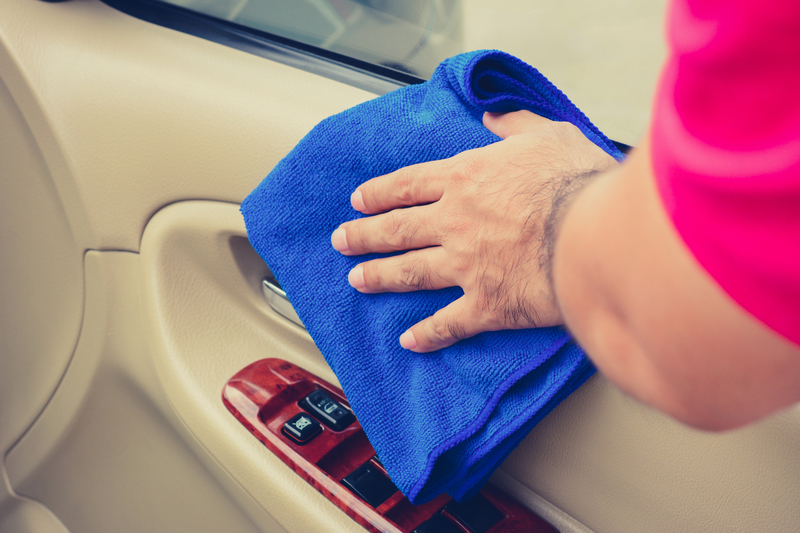Achieve a Pristine Stovetop by Conquering Burnt Residue
Posted on 19/08/2025
Achieve a Pristine Stovetop by Conquering Burnt Residue: The Ultimate Cleaning Guide
A squeaky-clean, gleaming stovetop is the hallmark of a well-kept kitchen. But, if you're like most home cooks, you've faced the common headache of burnt residue stubbornly clinging to your stove. Whether it's from overflowing pots or frying splatters, these burnt-on messes can make your kitchen look neglected. The good news? You can achieve a pristine stovetop by tackling even the toughest burnt residue with the right techniques and persistence.
Why You Need to Remove Burnt Residue Regularly
Letting burnt-on gunk and grease accumulate doesn't just dull your stove's appearance. Over time, it can cause:
- Decreased performance: Burnt residue can clog gas burners or interfere with electric heating elements, affecting how evenly your food cooks.
- Bad odors: Old food debris emits unpleasant smells whenever you use your stove.
- Potential fire hazard: Excessive grease buildup increases the risk of kitchen fires.
- Stubborn stains: The longer residue sits, the harder it becomes to remove, leading to permanent stains or even surface damage.

Understanding Your Stove: Materials & Cleaning Considerations
Before you start the journey to a spotless stovetop, it's essential to identify your stove's surface type. Cleaning methods can vary based on the material, and using the wrong approach can lead to scratches or discoloration.
- Enamel-coated stoves: Durable but can chip if scrubbed aggressively. Avoid harsh abrasives.
- Glass or ceramic stovetops: Sensitive to scratching. Use non-abrasive cleaners and specially designed scrapers.
- Stainless steel stoves: Prone to water marks and scratches. Always rub in the direction of the grain and dry thoroughly.
- Gas stoves: Combine one or more of the above; removable burners add complexity.
*Always consult your stove's manual to double-check the best cleaning practices for your specific model.*
Step-by-Step Guide: How to Remove Burnt Residue Effectively
Ready to achieve a pristine stove surface? Follow these battle-tested steps for conquering burnt residues once and for all:
1. Safety First: Switch Off and Let Cool
Never attempt cleaning while your stove is hot. Not only could you burn yourself, but you also risk damaging the surface. Unplug electric stoves, turn off gas supply if needed, and allow all components to cool completely before beginning.
2. Remove Removable Parts
Most stoves have detachable burners, grates, and knobs. Gently remove these components and set them aside for a separate, thorough cleaning. Soaking them in hot, soapy water is often effective for loosening greasy or burnt grime.
3. Wipe Away Loose Debris
Use a paper towel or dry microfiber cloth to wipe off crumbs, loose char, and surface-level residue. This prevents you from rubbing loose particles back into the surface during deeper cleaning.
4. Apply a Cleaning Solution (DIY or Commercial)
There are numerous ways to deal with stubborn burnt food on a stovetop:
- Baking soda paste: Mix baking soda with water until it reaches a spreadable consistency. Its gentle abrasiveness is excellent for stuck-on messes while being kind to most surfaces.
- Vinegar spray: The acetic acid in vinegar helps dissolve mineral deposits and grease. Fill a spray bottle with equal parts water and white vinegar. Use caution on stone or marble surfaces to avoid etching.
- Store-bought stovetop cleaners: Specialized products are formulated for glass, ceramic, or enamel finishes. Always read labels for compatibility.
5. Tackle Burnt Residue with the Right Tools
The secret to removing stubborn stovetop residue often lies in using the correct implement:
- Non-scratch sponges: Safe for most surfaces but powerful enough to dislodge soft debris.
- Plastic or silicone spatulas: Useful for gently prying up thick, burnt-on remains without leaving scratches.
- Razor-blade scrapers: Designed for glass cooktops, these can lift baked-in gunk with ease. Always hold at a low angle and avoid excessive pressure.
- Magic Eraser: Melamine foam erasers are effective on many surfaces, but test in a hidden spot first.
6. Wipe, Rinse, and Repeat as Needed
After scrubbing, wipe the area clean with a damp microfiber cloth to remove all cleaning residues. If any burnt spots remain, repeat the process--persistent stains may require several passes.
7. Clean and Dry Removable Parts
Scrub grates, burners, and knobs with a stiff brush or non-abrasive pad, then thoroughly rinse and allow to air dry. For really tough gunk, soak in a mixture of baking soda and vinegar to break down the residue.
8. Reassemble and Polish
Replace all components on your stove. For a finishing touch, gently buff the surface with a soft, dry cloth. Stainless steel or glass cleaner can add extra shine for a truly pristine stovetop.
Pro Tips for Achieving a Spotless Stovetop
Want to keep your stove looking as flawless as possible? Incorporate these professional cleaner secrets into your routine:
- Spot clean after every use. Don't wait for spills to become burnt-on; wipe up immediately, if safe.
- Deep clean weekly. Set a regular schedule for a more intensive scrub, paying special attention to hard-to-reach nooks.
- Use burner liners or mats. Specially designed, heat-resistant liners catch spills and are dishwasher-safe for easy cleaning.
- Avoid harsh chemicals. Opt for gentle, eco-friendly cleaning agents to maintain longevity and protect finishes.
- Curb moisture buildup. Always dry the stovetop after cleaning to prevent water stains and mineral residue.
- Check your exhaust fan or hood. Keeping the surrounding area clean reduces grease splatter and airborne particles landing back on your stove.
Troubleshooting: Tackling the Most Stubborn Burnt Residue
Despite your best efforts, some burnt-on spots seem almost impossible to shift. Consider these targeted tactics:
- For sugar or caramel burns: Sugar burns hard and fast, creating sticky, glass-like patches--especially on ceramic cooktops. Try using a damp towel warmed in the microwave to soften residue, then scrape carefully with a glass-safe blade.
- For melted plastic: Turn off the stove. Once cool, harden remaining plastic with an ice pack, then gently remove it with a plastic scraper.
- For old, carbonized stains: Make a thick paste of hydrogen peroxide and baking soda. Apply, cover with plastic wrap, and let it soak overnight before scrubbing.
- Persistent greasy build-up: Warm vinegar or lemon juice can help dissolve layers of old grease before regular cleaning.
Stubborn residue can sometimes require patience and repetition, but most marks will yield to a combination of soaking, careful scraping, and non-abrasive cleansers.
What to Avoid When Cleaning Burnt Stovetop Residue
While enthusiasm is admirable, aggressive cleaning tactics can cause lasting damage to your appliance. Avoid the following:
- Using steel wool or harsh scouring pads--these will scratch and dull glass, enamel, and stainless steel.
- Applying oven cleaner unless specified by the manufacturer--these are too aggressive for most cooktops.
- Mixing chemicals, such as bleach with ammonia--this is dangerous and can produce toxic fumes.
- Scraping with sharp knives--always use blades or scrapers designed for cooktop use.
How to Maintain a Pristine Stovetop All Year Long
Consistency is key to a spotless kitchen. Build these habits to prevent burnt-on messes from forming:
- Wipe the stovetop immediately after accidental spills (when cool).
- Use spill shields or boilover guards for messy recipes.
- Regularly inspect burners for remnants of burnt food or grease.
- Include the stovetop in your regular kitchen cleaning checklist.
- Educate all family members about proper use and cleaning to avoid accidents and residue buildup.

Frequently Asked Questions About Burnt Stovetop Residue
Can I use a razor blade on my glass stovetop?
Yes, if the manufacturer recommends it. Always use a new, clean razor blade held at a steep angle and never dig into the glass. Specialized cooktop scrapers are safest.
What's the fastest way to clean burnt residue?
For most fresh spills, a combination of baking soda, vinegar, and mild scrubbing is both quick and safe. The key is to act before the residue bakes in for a long time.
How often should I deep clean my stovetop?
If you cook daily, aim for a deep clean at least once a week. Frequent cleaning prevents burnt residue from becoming a bigger problem, making every session easier and faster.
Are natural cleaners as effective as commercial products?
Absolutely! Solutions like baking soda and vinegar work for many forms of stubborn residue. Some commercial cleaners can speed up the process, but always ensure they're safe for your stovetop's material.
Conclusion: A Pristine Stovetop is Within Reach
Achieving a pristine, spotless stovetop isn't just about appearances--it's a vital measure for safety, kitchen hygiene, and ensuring your stove runs at peak performance. With these burnt residue removal tips and preventive strategies, your stovetop can look showroom-new all year round.
Make cleaning part of your post-cooking ritual, and never let burnt-on messes linger. Your kitchen will sparkle, and you'll cook every meal with confidence.
- Say goodbye to stubborn burnt residue.
- Hello to a gleaming, flawless stovetop every day!





